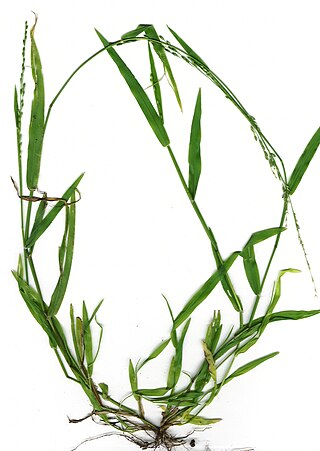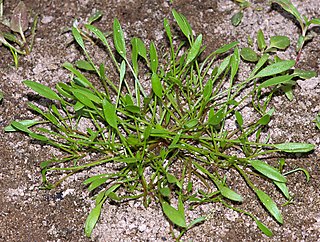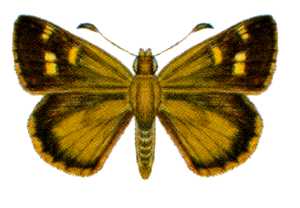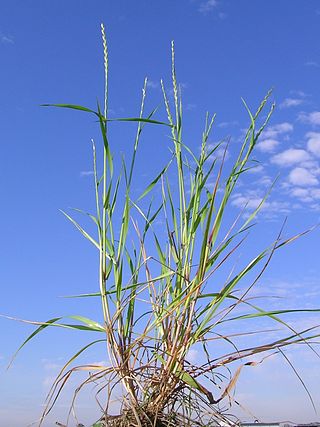
Trichosanthes cucumerina is a tropical or subtropical vine. Its variety T. cucumerina var. anguina raised for its strikingly long fruit. In Asia, it is eaten immature as a vegetable much like the summer squash and in Africa, the reddish pulp of mature snake gourd is used as an economical substitute for tomato. Common names for the cultivated variety include snake gourd, serpent gourd, chichindapadwal and Snake Tomato.

Ehrharta is a genus of plants in the grass family.

Ehrharta erecta is a species of grass commonly known as panic veldtgrass. The species is native to Southern Africa and Yemen. It is a documented invasive species in the United States, New Zealand, Australia, southern Europe and China.
Annual ryegrass toxicity (ARGT) is the poisoning of livestock from toxin contained in bacterially infected annual ryegrass. The toxin is produced by the bacterium Rathayibacter toxicus, which is carried into the ryegrass by the nematode Anguina funesta.
Rathayibacter tritici is a Gram-positive soil bacterium. It is a plant pathogen and causes spike blight in wheat.

Anguina agrostis is a plant pathogenic nematode.

Anguina is a genus of plant pathogenic nematodes.
Anguina graminis, the fescue leaf gall nematode, is a plant pathogenic nematode.
Anguina balsamophila is a plant pathogenic nematode in mules ear.
Anguina spermophaga is a plant pathogenic nematode, that attacks sugarcane.

Limosella is a genus of flowering plants known as mudworts. These are annual, largely aquatic plants, found in muddy areas worldwide. Its phylogeny and biogeography are inferred from molecular data

Hippobroma longiflora, also called Star of Bethlehem or madamfate, is a flowering plant in the family Campanulaceae. It is the only species in the genus Hippobroma. It is endemic to the West Indies, but has become naturalized across the American tropics and Oceania.

Pigeon Island is a small island located need the middle of the Wallabi Group of the Houtman Abrolhos, an archipelago off the coast of Western Australia. It is almost entirely given over to western rock lobster fishers' camps, and as a result is far more disturbed than most other islands in the archipelago. A nearby island also seasonally populated by fishers is named Little Pigeon Island, hence Pigeon Island is sometimes referred to as "Big Pigeon Island".

Ehrharta calycina is a species of grass known by the common names perennial veldtgrass and purple veldtgrass.

Anisynta sphenosema, the wedge grass-skipper or wedge skipper, is a species of butterfly of the family Hesperiidae. It is found in the south-west quarter of Australia.

Taractrocera papyria, the white-banded grass-dart, is a butterfly of the family Hesperiidae. It is found in the Australian Capital Territory, New South Wales, Queensland, South Australia, Tasmania, Victoria and Western Australia.
Rathayibacter toxicus is a phytopathogenic bacterium known for causing annual ryegrass toxicity (ARGT) commonly found in South and Western Australia.

Lolium rigidum is a species of annual grass. Common names by which it is known include annual ryegrass, a name also given to Italian ryegrass, rigid ryegrass, stiff darnel, Swiss ryegrass and Wimmera ryegrass. It is a native of southern Europe, northern Africa, the Middle East and the Indian subcontinent and is grown as a forage crop, particularly in Australia, where it is also a serious and economically damaging crop weed.










